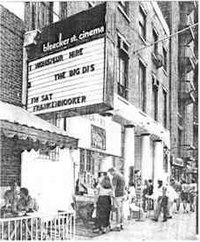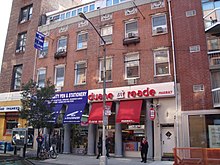 Bleecker Street Cinema, looking east. | |
|
| |
| Former names |
Mori (1883–1937) Montparnasse |
|---|---|
| Address | 144
Bleecker Street New York City, New York |
| Location | 144
Bleecker Street Manhattan, New York City, New York |
| Owner | Placido Mori, New York University, Lionel Rogosin, Sid Geffen, Jackie Raynal, John Souto |
| Type | restaurant, art house movie theatre |
| Capacity | 200 |
| Construction | |
| Built | 1832 |
| Opened | 1883 |
| Renovated | 1883, 1960 |
| Closed | September 2, 1991 |
| Architect | Raymond Hood |
The Bleecker Street Cinema was an art house movie theater located at 144 Bleecker Street in Manhattan, New York City, New York. It became a landmark of Greenwich Village and an influential venue for filmmakers and cinephiles through its screenings of foreign and independent films. It closed in 1990, reopened as a gay adult theater for a short time afterward, then again briefly showed art films until closing for good in 1991.
History

The building at 144 Bleecker Street in Greenwich Village that would eventually house the Bleecker Street Cinema was originally built in 1832 as two rowhouses at 144 and 146 Bleecker Street. Placido Mori converted 144 into the restaurant Mori in 1883. [1] As architecture historian Christopher Gray wrote:
At some point, [Placido] Mori befriended a novice architect, Raymond Hood, gave him a house tab and an apartment upstairs and in 1920 had him design a new facade for the building to include 146 Bleecker. Hood gave the buildings a row of Doric columns across the first floor, imitation Federal lintels over the windows and a setback penthouse studio. [1]
Mori closed in 1937. The building remained unoccupied until 1944 when political and activist organizations including Free World House headquartered there for two years. Sometime afterward, the space became the Restaurant Montparnasse. [1] By 1959, the building was owned by New York University. [2]
Filmmaker and social activist Lionel Rogosin founded the 200-seat Bleecker Street Cinema in 1960 in order to exhibit his controversial 1959 film Come Back, Africa. [3] [4] In the early 1960s, the independent-filmmakers' group The Film-Makers' Cooperative, of which Rogosin was a supporter, showed experimental movies there as midnight screenings. [5] Soon the venue became, in the words of film critic and historian James Hoberman, one of "three key revival houses: The New Yorker, the Bleecker Street [Cinema], and the Thalia", in New York City during the 1950s and 1960s. [6]
Film critic Rudy Franchi, at one time the theater's program director, recalled that the house cat, Breathless, named for that Godard film, [7] would often "escape from the office area and start to climb the movie screen. ... I would sometimes get a buzz on the house phone from the projection booth with the terse message 'Cat's on the screen.'" [8] The theater cat at the venue's 1990 closing was named Wim, after director Wim Wenders. [2]
Sid Geffen purchased the theater in 1973 [2] or 1974, [3] and ran it with his wife, then named Jackie Raynal. [2] That same year, Geffen bought the Carnegie Hall Cinema, housed underground beneath the famed music hall. [6] Future October Films co-founder and United Artists studio executive Bingham Ray began his film career in 1981 as a manager and programmer at the theater, [9] and longtime Film Forum programmer and film historian Bruce Goldstein had his first New York theater job at Geffen's two venues. [10] Geffen died in 1986. [11]

In 1990, his widow, by then remarried and named Jackie Raynal-Sarré, [12] said that because Geffen left no will, she partnered with developer John Souto to buy out Geffen's children from a previous marriage. [2] She further said that Souto, after renting to her for four years for $160,000 annually, raised the rent to $275,000, more than the theater could sustain. Following a lawsuit and court proceedings, a judge ordered the two co-owners to bid on the building. "We came in with [a] $3.3 million [bid] and he came in with $3.4 million," Raynal-Sarré said. [2] In its final configuration, it had a main auditorium of 171 seats, and the 78-seat James Agee Room. [13]
The theater closed on September 6, 1990. The last film to start was Aki Kaurismäki's 74-minute Ariel, and the last film to end was the nearly two-hour Jesus of Montreal. [2] The last film in the James Agee Room was Roger Stigliano's Fun Down There. [11]
By November of that year, Bleecker Street Cinema had reopened as a gay adult-film theater. [1] Some time afterward it returned to its art-house roots, but then closed for good on Monday night, September 2, 1991. Its final features were Alex van Warmerdam's Dutch comedy Voyeur; the documentary Jimi Hendrix at the Isle of Wight; Ari Roussimof's war-veteran drama Shadows in the City; and Francis Teri's horror movie Suckling. [13] The theater's final operator was Nick Russo Nicolaou. [13]
Influence and legacy
The foreign and independent-film programming of the Bleecker Street Cinema helped inspire future filmmakers and contributed to the cinematic education of film historians, critics and academics. As one historian wrote:

Sid Geffen was one of a series of men who made a huge difference in film history through their exhibition choices in New York City. Geffen, who ran the Bleecker Street Cinema in the crucial years of the late seventies and early eighties, along with Amos Vogel and Fabiano Canosa, significantly affected the course of film history. [14]
In popular culture
Several scenes in Desperately Seeking Susan (1985) were shot at the Bleecker Street Cinema, as one of the characters (Dez, played by Aidan Quinn) works there as a projectionist. [15] In Woody Allen's 1989 Crimes and Misdemeanors, the character played by filmmaker-star Allen visits the Bleecker Street Cinema to see Alfred Hitchcock's Mr. and Mrs. Smith and the 1943 musical Happy Go Lucky. [15] It also appears in the films The Prince of Tides [2] and Maniac Cop. [16]
See also
- 55th Street Playhouse—another Manhattan theater which showed art-house films
- Film Forum
- IFC Center
- New Andy Warhol Garrick Theatre—nearby at 152 Bleecker Street (until 1970s)
- Quad Cinema
References
- ^ a b c d Gray, Christopher (November 4, 1990). "Streetscapes: The Bleecker Street Cinema; The 'Lost' Frescoes of an Artist-Soldier". The New York Times. Retrieved April 7, 2013.
- ^ a b c d e f g h Lovece, Frank (September 8, 1990). "The Last Picture Show: Bleecker Street Cinema at End of 31-Year Reel". New York Post. Archived from the original on August 31, 2020. Retrieved April 5, 2013.
- ^ a b Rogosin, Lionel (2007). "The Building of an Alternate Cinema". Lionel Rogosin (official site). Archived from the original on October 5, 2013. Retrieved April 7, 2013. While some sources give 1962, founder Rogosin states the theater opened in 1960.
- ^ Modisane, Litheko (2013). South Africa's Renegade Reels: The Making and Public Lives of Black-Centered Films. Palgrave Macmillan. p. 41. ISBN 978-1137027023.
-
^ Pierson, Michele; James, David E.; Arthur, Paul, eds. (2011). "Introduction". Optic Antics: The Cinema of Ken Jacobs.
Oxford University Press, USA. p.
21 (footnote 30).
ISBN
978-0195384970.
{{ cite book}}:|first3=has generic name ( help)CS1 maint: multiple names: authors list ( link) - ^ a b Hoberman, James (December 29, 1975). "The Movie Freak's Guide to Film in New York". New York. p. 73.
- ^ Daugherty, Tracy (2009). Hiding Man: A Biography of Donald Barthelme. St. Martin's Press. p. 230. ISBN 978-0312378684.
- ^ Daugherty, p. 231
- ^ Vanairsdale, S.T. (January 23, 2012). "Bingham Ray, Indie Legend and Sundance Regular, Dead at 57". Movieline.com. Archived from the original on January 24, 2012. Retrieved April 7, 2013.
- ^ Tallmer, Jerry (March 24–30, 2004). "Film Forum programmer has had an award-winning run". The Villager. Vol. 73, no. 47. Greenwich Village. Archived from the original on June 30, 2004. Retrieved April 7, 2013.
- ^ a b Yarrow, Andrew L. (August 17, 1990). "Another Prized Theater for Art Films Is Closing". The New York Times. Retrieved April 7, 2013.
- ^ Per Lovece, New York Post, she was married to psychologist Jean-Paul Sarré; they appear together in Gérard Courant's 1986 short film "Jackie Raynal and Jean-Paul Sarré" from the filmmaker's "Couples" series. Per Jackie Raynal's official site( Archived on November 22, 2014), she later married real-estate businessman and film producer Joseph J.M. Saleh, and became known as Jackie Raynal-Saleh.
- ^ a b c Honan, William H. (August 28, 1991). "Bleecker Street Cinema Closing". The New York Times. Retrieved April 7, 2013.
- ^ Rick, B. Ruby (1998). Chick Flicks: Theories and Memories of the Feminist Film Movement. Duke University Press. p. 105. ISBN 978-0822321217.
- ^ a b Alleman, Richard (2005). New York: The Movie Lover's Guide: The Ultimate Insider Tour of Movie New York. Broadway. p. 256. ISBN 978-0767916349.
- ^ Lustig, William (1988-05-13), Maniac Cop (Action, Crime, Horror), Tom Atkins, Bruce Campbell, Laurene Landon, Shapiro-Glickenhaus Entertainment, retrieved 2024-04-05
External links
- "Bleecker Street Cinemas in New York, NY". CinemaTreasures.org. 2020-03-29. Retrieved 2020-03-29.
- Lounsbury, Myron (2012-07-22). "The Bleecker Street Cinema". University of Maryland. Archived from the original on 2012-07-22. Retrieved 2020-03-29.
- "Authors: Films and videos by Jackie Raynal". Cinédoc.org. Archived from the original on 2015-06-14. Retrieved 2013-04-05.
- 1960 establishments in New York City
- 1991 disestablishments in New York (state)
- Cinemas and movie theaters in Manhattan
- Entertainment companies established in 1960
- Cultural history of New York City
- Former theatres in Manhattan
- Greenwich Village
- Repertory cinemas in the United States
- Entertainment companies disestablished in 1991